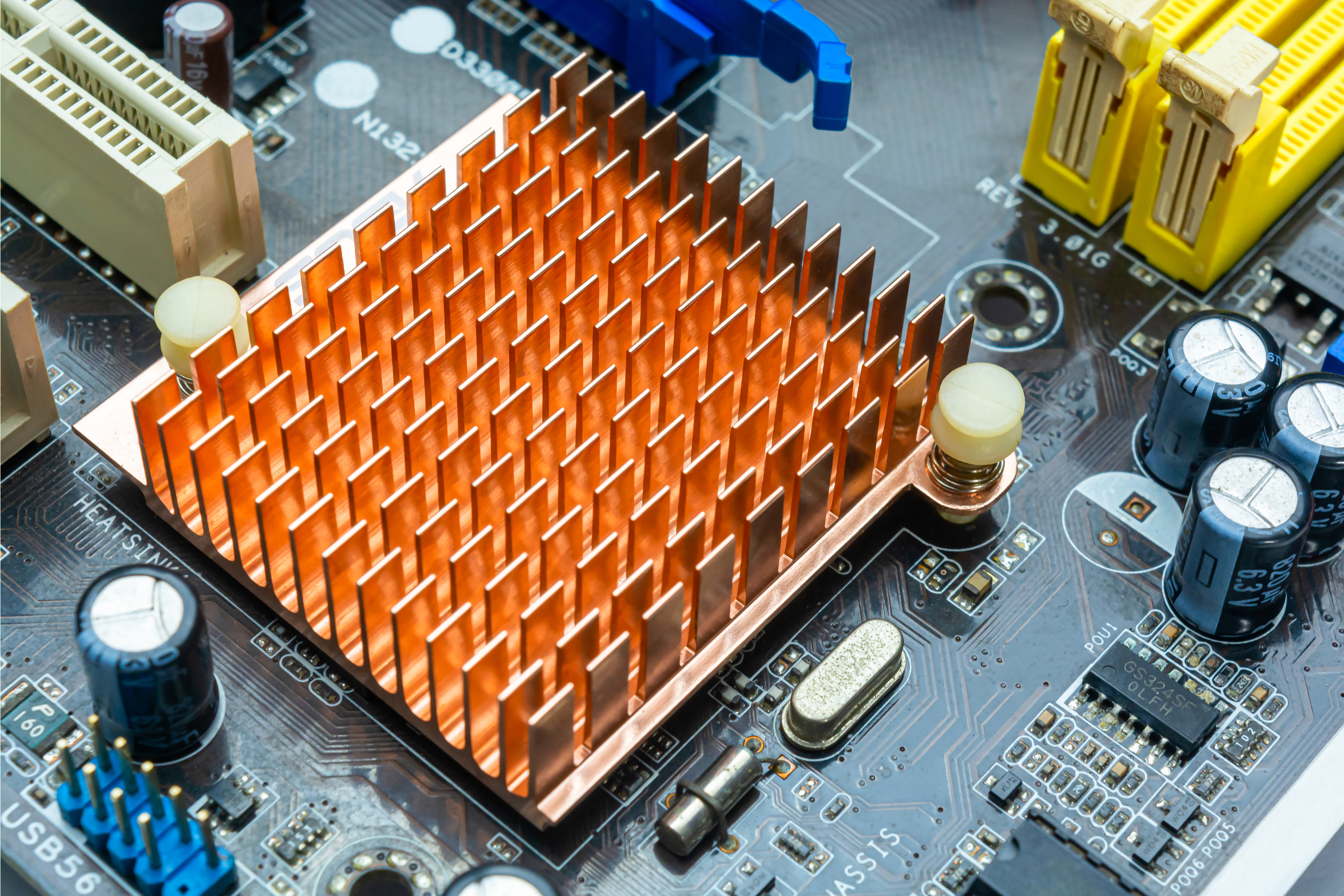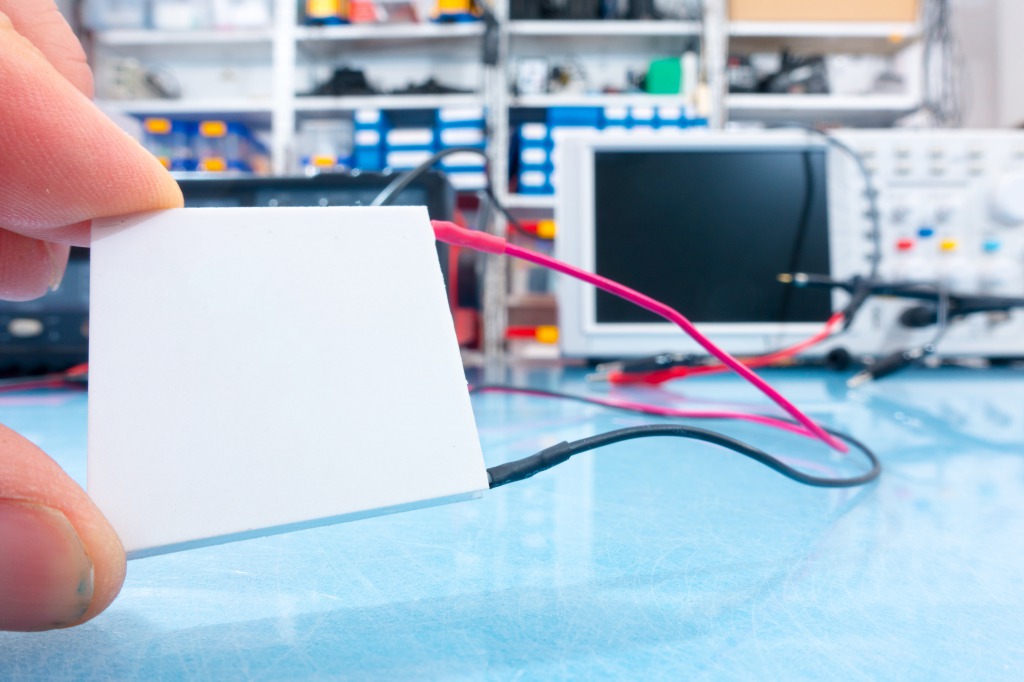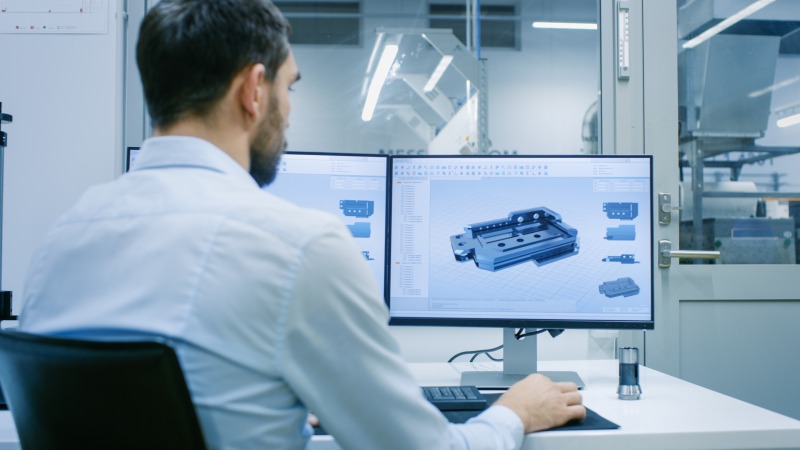What are Heat Sinks?
Deepen Understanding of an Essential Component for Electronics Cooling
Heat sinks are indispensable components for effective heat management of a wide variety of machines and devices, including electronic devices, terminals, and systems. Knowing heat sinks can lead you to the achievement of efficient heat removal so that you can keep your device cool and run properly. This article navigates you to learn everything you need to know about heat sinks, covering:
• The definition of a heat sink
• Applications
• How it works
• Types, material, and structures
You can also get a big picture about heat sinks through comparison with other heat removal devices. Let’s get started.

See 11 related fields
INDEX
- What is a Heat Sink?
- What Can Heat Sinks be Used for?
- How Does a Heat Sink Work?
- Heat Sink Types
- Heat Sink Material
- Heat Sink Structure
- Comparisons between Heat Sinks and Other Heat Dissipation Devices
- DNP’s Vapor Chambers
What is a Heat Sink?
Electronic devices like computers generate heat when they are in operation. This heat, if not treated properly, could cause the CPU to overheat, leading to malfunction or permanent damage to the device. The same thing is true for advanced smaller electronic devices and gadgets, which are powerful, yet they are not free from heat dissipation issues. Therefore, heat dissipation devices are essential, and one of them is a heat sink. So what is a heat sink?
Heat sinks are widely used for cooling parts and components that produce heat while in use. The simple answer to the question, “What is a heat sink?”, is that it gradually transfers heat energy away from a heat source. So, in a sense, heat sinks are closely tied to electronics cooling. The purpose of using a heat sink is to properly remove heat from device components to improve device performance and extend its life. And usually, a heat sink incorporates a fan or other mechanism to reduce the temperature of a hardware component, such as a processor.
We know heat sinks are quite essential components, and they are made in a wide variety of ways. By focusing on heat sinks, this article looks at their applications, how they work, types, materials, and comparisons with other heat dissipation devices.
An example of a heat sink installation
|
|
What Can Heat Sinks be Used for?
Broadly speaking, heat sinks should be used for anything that is hot but that shouldn’t be. In other words, any equipment or device with a heat source, regardless if it is mechanical, electrical, chemical, nuclear, solar, or friction, needs heat dissipation to protect the entire system and components, as mentioned earlier. So then, what can heat sinks be used for?
For instance, heat sinks are actively used for vehicles, motors, and computers. Additionally, they also provide heat dissipation solutions for uninterruptible power supplies (UPS), variable-speed motor controls, welding units, power rectification equipment, and laser power supplies. In electronics, heat sinks are typically used for cooling solutions for electric vehicle controllers, battery-pack cooling solutions, and IT telecommunication cooling.
So, we can see that heat sink applications range from large power equipment to small electronic devices, including laptops, smartphones, and tablets. Now let’s take a look at how it works.
How Does a Heat Sink Work?
Simply put, a heat sink is an object that disperses heat from a heat source. They are also installed on computers, DVD players, and other portable devices. When thinking about a simple mechanism that illustrates how a heat sink works, you can imagine a radiator installed in a vehicle. A radiator draws heat away from the car’s engine. Similarly, a heat sinks also draws heat away from, for example, your PC’s CPU. The mechanism by which a heat sink works is closely related to thermal conduction which occurs whenever two objects at different temperatures are in contact.
This involves the collisions between the fast molecules of the hotter object with the slow-moving molecules of the colder object. This also leads to the energy transfer from the hot object to the cooler object. A heat sink thus transfers the heat from the high-temperature component such as a transistor to the low-temperature medium such as air, oil, water, or any other suitable medium through conduction and then convection.
Heat sinks have a thermal conductor that carries heat away from the heat source into fins or pins that provide a large surface area for the heat to dissipate throughout the rest of the computer. This is why a heat sink is designed to maximize its surface area in contact with the cooling medium surrounding it. So, the heat sink’s performance depends on the air velocity, material, protrusion design, and surface treatment. This fact leads us to explore heat sink’s types, materials, and structures.
Heat Sink Types
Although heat sinks are almost always made from metal, different types exist. And heat sink types are broadly divided into two types, active and passive. Let’s check out some differences between these two heat sink types.
Active heat sinks
An active heat sink has a powered device such as a fan, water pump, or air blower to enhance cooling capacity. Such powered devices mounted on a heat sink push or pull a constant fresh air flow across the metal cooler, making thermal dissipation much more effective. Some active heat sinks use water or other liquids to carry heat away from a heat source. Active heat sinks are widely used as a temperature control system in electronics, protecting and enhancing the performance of various chips, LEDs, ICs, and other modules.
One of the advantages of active heat sinks is that they are more compact than passive heat sinks. Passive heat sinks do not have a fan or other means of moving warm air away from the heat sink, so they need to be physically larger to carry heat away. Because active heat sinks rely on forced air to be passed across the fin area, they are more efficient, which translates to a smaller and lighter heat sink design.
Active heat sinks are usually easy to install and remove, while they are widely used for cooling PC components including CPUs and GPUs. It would also be best to remember to apply thermal paste between the parts of the CPU chip and metal heat sink parts that come into contact to facilitate heat conduction more efficiently.
Passive heat sinks
Unlike active heat sinks, passive heat sinks do not have any powered devices like fans within their design and are typically larger than active heat sinks. Because of using the extra surface area of the device to improve thermal cooling, which is the trade-off for lacking a fan and its high heat removal capacity, they tend to be larger. Combined with a typical finned or pin layout, passive heat sinks require a large surface area to transfer heat into the atmosphere.
The purpose of using such passive heat sinks, rather than using active heat sinks, is to reduce noise and eliminate the risk of overheating caused by fan failure. They are often used on lower power draw electronics or machinery that does not get hot enough to warrant active cooling. Additionally, the cost effectiveness cannot be ignored, since they are inexpensive solutions where very large components are impossible to install. But at the same time, they require a decent amount of clearance room around the part or component where they are installed.
Heat Sink Material
In most cases, heat sink materials for electronic cooling applications are always aluminum or copper. The following describes each material used for heat sinks.
Copper
Copper is frequently used as the core material and is twice as efficient as aluminum in conducting heat with thermal conductivity of around 400 W/m-K. With its outstanding heat-sink properties in terms of its thermal conductivity and corrosion resistance, copper can offer excellent, quick, and efficient heat dissipation capacity. But as for drawbacks, copper is three times heavier and quite a bit more expensive than aluminum. It is also more difficult to form when compared to aluminum.
Aluminum
Aluminum is an extremely light and inexpensive material with a high degree of thermal conductivity, making it an ideal choice for most heat sinks. Aluminum can be a more structurally robust metal when used in thin sheets. But the ability of aluminum to move heat, thermal conductivity, is about half that of copper. This drawback limits the distance that heat can be moved or conducted away from the heat source in the base of a heat sink.
Heat Sink Structure
Let’s look at heat sink structures in the following three types: cold plates, pin-fin heat sinks, and plate-fin heat sinks.
Cold plates
Many electronic devices produced these days need the performance of cooling to meet the thermal demands of certain hot components. Cold plates, including liquid cold plates, are common cooling systems in high-power lasers, fuel cells, battery coolers, motor drivers, medical equipment, and other high-heat flux applications. Cold plates provide localized cooling by transferring heat from a device to a medium that flows to a remote heat exchanger and dissipates into the ambient or another liquid in a secondary cooling system.
Pin-fin heat sinks
A pin-fin heat sink has an extrusion configuration with pins. In this structure, the core block is constructed with a cluster of pins or rods extending upward or outward from its base. The pins could take various forms, such as cylindrical, elliptical, or square. The advantages of pin-fin heat sinks include the low-cost design, but they do not provide a significant heat removal capacity for many applications. They are actually less widely used than fin heat sinks.
Plate-fin heat sinks
A plate-fin heat sink comes with straight fins that provide the heat sink with a much greater surface area to remove more heat energy. This design makes for a far more efficient and effective transfer of heat away from the component the cooler is attached to. Plate-fin heat sinks can be manufactured in various ways and used on a wide variety of applications, such as the outside of mechanical housings and enclosures, as they provide a simple solution that creates no noise or power consumption.
Comparisons between Heat Sinks and Other Heat Dissipation Devices
There exist various heat removal solutions and devices. What differentiates heat sinks from other such devices, and how are they different in applications? This section provides you with comparisons between heat sinks and other typical heat dissipation devices.
Plate heat exchangers
A plate heat exchanger uses metal plates to transfer heat between two fluids, which offers a highly efficient mechanism for heat transfer. It usually has a specialized design well suited to transferring heat between medium- and low-pressure fluids. The plates used in a plate and frame heat exchanger are obtained by the one-piece pressing of metal plates. Stainless steel is a commonly used metal for the plates because of its ability to withstand high temperatures, strength, and corrosion resistance. Their applications include water heaters, cooling tower isolation, waste heat recovery, and thermal storage systems.
The plate heat exchanger’s mechanism differs from a heat sink, because a heat sink basically aims to absorb heat from a heat source while releasing it into the air through fins or pins. As for the advantages, plate heat exchangers can be installed in various places and locations because of their flexibility and compact design. Lower costs in operating and maintenance including their eco-friendliness also make plate heat exchangers attractive. On the other hand, the entire plate heat exchanger unit tends to be larger. Therefore, plate heat exchangers are not the best solution for cooling small portable electronic devices.
Cooling radiators
A radiator is another type of heat exchanger, used for various applications including cars, buildings, and electronics. A typical application we can cite is engine cooling, but in electronics, radiators are also used for cooling CPUs for computers.
Usually, a radiator consists of a large amount of cooling surface exposed to large amounts of air so that it spreads through the water to cool it efficiently. To increase the surface area available for heat exchange with the surroundings, a radiator has multiple fins in contact with the tube carrying liquid pumped through the radiator. So, we can say that radiators have a similar structure to heat sinks. But radiators require a medium, such as water or oil, unlike heat sinks which usually use air as their medium.
Thermal paste
Thermal paste is a thermally conductive chemical compound commonly used as an interface between heat sinks and heat sources. Thermal paste can be a good choice to seal up gaps, like grooves, existing on the surface of the CPU and the heat sink’s contact plate. If not properly sealed up, these gaps allow air to come in between the processor and the heat sink, reducing the heat transfer efficiency. A common application is to drain waste heat generated by electrical resistance in semiconductor devices, including power transistors, CPUs, GPUs, and LED COB.
So, in a sense, thermal paste is used with a heat sink as a set. They complement each other. Thermal paste cannot dissipate heat by itself, while a heat sink also cannot fully demonstrate its heat removal capacity when used as a single unit. Applying thermal paste can contribute to improving the entire device or system performance with its ability to be easily spread. It also contributes significantly to prolonging the computer’s lifespan.
Thermal conductive sheets
Thermal conductive sheets, or heat dissipation sheets, are made of silicone or acrylic resin. The sheet-like structure is flexible with excellent adhesiveness. A thermal conductive sheet seems to work like thermal paste, but it is easier to use since you don’t have to apply it but just install it, for example, between the CPU and a heat sink. Therefore, they are widely used for heat dissipation of IC chips and batteries installed in small home appliances and electronic devices, combined with other heat transfer components such as heat sinks.
On the other hand, thermal conductive sheets and heat sinks can demonstrate their full cooling performance when they are used in tandem, similar to the relationship between thermal paste and a heat sink. This results in the further benefit of increasing the device and system lifespan.
Vapor Chambers
A Vapor Chamber is a two-phase device used as a thermal management solution. Usually, a Vapor Chamber is composed of flat heat pipes with very high thermal conductance, having flat surfaces on the top and bottom sides. Operating on the same principles as heat pipes, a Vapor Chamber houses vapor within a chamber instead of a pipe, thus it is so named a Vapor Chamber. Composed of thin plates having precisely formed grooves and a wick structure sealed together, Vapor Chambers contain a small amount of fluid, allowing heat to be dispersed away from the source.
Vapor Chambers have extremely high conductance and can transfer a large amount of heat. Though they tend to be priced higher than heat sinks, Vapor Chambers can take advantage of their flat design as they are used for electronics cooling, such as smartphones, wearable devices, and other electronic communication products.
DNP’s Vapor Chambers
DNP has developed powerful thin Vapor Chambers as the industry leader by taking full advantage of its ultrafine processing technology. They are highly conductive but flexible to fit complicated platforms with curved planes and multiple levels. Thanks to such fantastic flexibility, their design can adapt to a wide variety of forms and shapes that conventional Vapor Chambers have never been able to achieve.
DNP’s Vapor Chambers are expected to be widely used for a variety of applications as a significant shift toward 5G electronic devices is occurring in the industry. They are also expected to demonstrate their real strength in various electronic devices, including 5G smartphones, thin laptops, and tablets. They are also the best heat dissipation solution for wearables, such as VR, AR, and MR terminals, along with drones, and electronic vehicles.
Manufacturing such attractive Vapor Chambers has been brought about by DNP’s high-definition patterning technology including chemical etching which has become a significant strength in producing thin Vapor Chambers. By making full use of its knowledge covering a more comprehensive range of industries and ever-extending networks, DNP will seek and pursue unique heat management solutions that only DNP can develop. (Information as at Feburary,2022)
|
|
Other columns and featured articles
-
Thermoelectric Cooler Module
- Precision Devices and Components

Learn more about thermoelectric cooler modules in this article. This article will answer the followi...
-
The Basics of Fanless Cooling Technology
- Precision Devices and Components

Find all of the essential information you need on fanless cooling technology. When a computer is ope...
-
Basics of Thermal Dissipation - Definition, Mechan...
- Precision Devices and Components

Learn more about thermal dissipation and the factors that influence it in this article. Thermal diss...
-
The Basics of Heat Pipes – Their History, Principl...
- Precision Devices and Components

What are heat pipes, how do they work, and what varieties are available? Heat pipes are characterize...
-
Laptop Heat Dissipation and Heat Management
- Precision Devices and Components

An introduction to heat dissipation components that are effective in heat management based on the pr...
-
Heat Dissipation Design Guide for Electronics
- Precision Devices and Components

An explanation of the basics of "heat dissipation design" and how to apply it to electroni...
-
Electronics Cooling – A Review through Methods and...
- Precision Devices and Components

An explanation of electronics cooling methods and types of electronics cooling equipment Greater pro...
-
Types and Characteristics of Heat Dissipation Mate...
- Precision Devices and Components

An explanation of the characteristics of heat dissipation materials and components and important poi...
-
Heat Pipes vs. Vapor Chambers
- Precision Devices and Components

Learn differences in performance and applications between Vapor Chambers and heat pipes The latest e...
See 11 related fields

